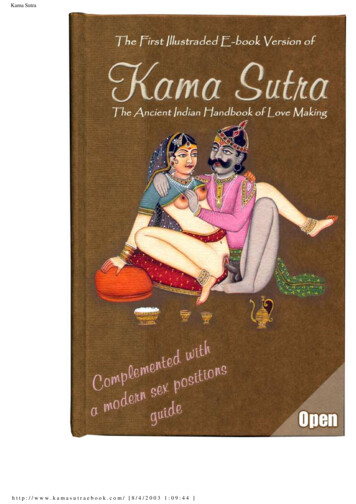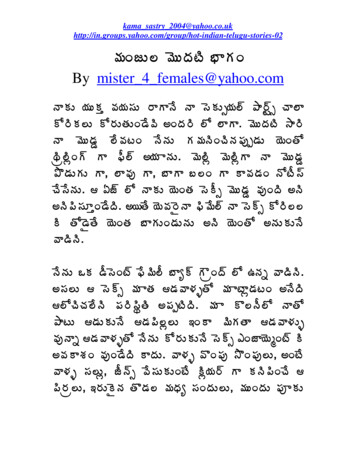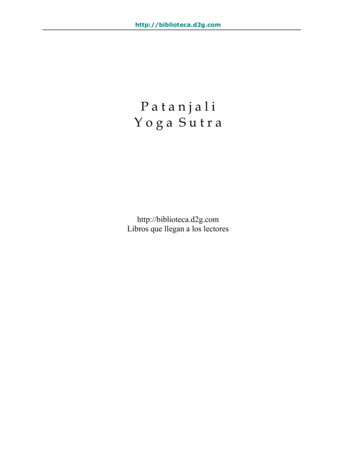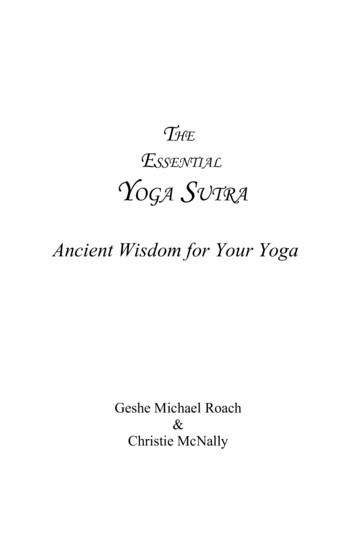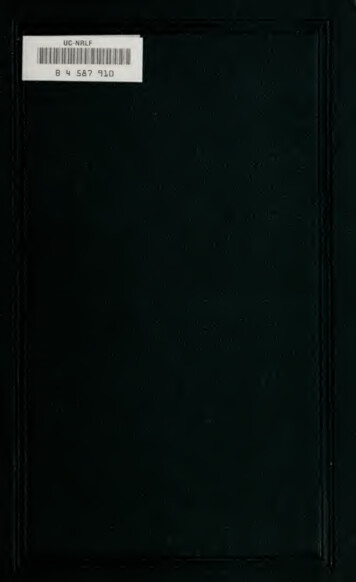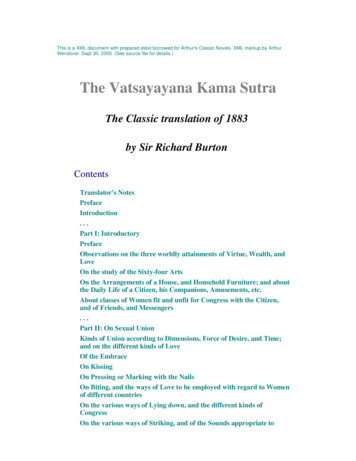
Transcription
This is a XML document with prepared etext borrowed for Arthur's Classic Novels. XML markup by ArthurWendover. Sept 30, 2000. (See source file for details.)The Vatsayayana Kama SutraThe Classic translation of 1883by Sir Richard BurtonContentsTranslator's NotesPrefaceIntroduction.Part I: IntroductoryPrefaceObservations on the three worldly attainments of Virtue, Wealth, andLoveOn the study of the Sixty-four ArtsOn the Arrangements of a House, and Household Furniture; and aboutthe Daily Life of a Citizen, his Companions, Amusements, etc.About classes of Women fit and unfit for Congress with the Citizen,and of Friends, and Messengers.Part II: On Sexual UnionKinds of Union according to Dimensions, Force of Desire, and Time;and on the different kinds of LoveOf the EmbraceOn KissingOn Pressing or Marking with the NailsOn Biting, and the ways of Love to be employed with regard to Womenof different countriesOn the various ways of Lying down, and the different kinds ofCongressOn the various ways of Striking, and of the Sounds appropriate to
themAbout females acting the part of MalesOn holding the Lingam in the MouthHow to begin and how to end the Congress. Different kinds ofCongress, and Love Quarrels.Part III: About The Acquisition Of A WifeObservations on Betrothal and MarriageAbout creating Confidence in the GirlCourtship, and the manifestation of the feelings by outward signs anddeedsOn things to be done only by the Man, and the acquisition of the Girlthereby. Also what is to be done by a Girl to gain over a Man andsubject him to herOn the different Forms of Marriage.Part IV: About A Wife On the manner of living of a virtuous Woman,and of her behaviour during the absence of her HusbandOn the conduct of the eldest Wife towards the other Wives of herHusband, and of the younger Wife towards the elder ones. Also on theconduct of a Virgin Widow remarried; of a Wife disliked by herHusband; of the Women in the King's Harem; and of a Husband whohas more than one Wife.Part V: About The Wives Of Other PeopleOn the Characteristics of Men and Women, and the reason whyWomen reject the Addresses of Men.About Men who have Success with Women, and about Women who areeasily gained overAbout making Acquaintance with the Woman, and of the efforts togain her overExamination of the State of a Woman's mindThe Business of a Go-BetweenOn the Love of Persons in authority with the Wives of other PeopleAbout the Women of the Royal Harem, and of the keeping of one's ownWife.Part VI: About CourtesansIntroductory RemarksOf the Causes of a Courtesan resorting to Men; of the means ofAttaching to herself the Man desired, and the kind of Man that it isdesirable to be acquainted with
Of a Courtesan living with a Man as his WifeOf the Means of getting Money; of the Signs of a Lover who isbeginning to be Weary, and of the way to get rid of himAbout a Reunion with a former LoverOf different kinds of GainOf Gains and Losses, attendant Gains and Losses, and Doubts; andlastly, the different kinds of CourtesansPart VII: On The Means Of Attracting Others To One's SelfOn Personal Adornment, subjugating the hearts of others, and of tonicmedicinesOf the means of exciting Desire, and of the ways of enlarging theLingam. Miscellaneous Experiments and ReceiptsConcluding RemarksPrefaceIN the literature of all countries there will be found a certain number of workstreating especially of love. Everywhere the subject is dealt with differently, andfrom various points of view. In the present publication it is proposed to give acomplete translation of what is considered the standard work on love in Sanscritliterature, and which is called the 'Vatsyayana Kama Sutra', or Aphorisms onLove, by Vatsyayana.While the introduction will deal with the evidence concerning the date of thewriting, and the commentaries written upon it, the chapters following theintroduction will give a translation of the work itself. It is, however, advisable tofurnish here a brief analysis of works of the same nature, prepared by authorswho lived and wrote years after Vatsyayana had passed away, but who stillconsidered him as the great authority, and always quoted him as the chief guideto Hindoo erotic literature.Besides the treatise of Vatsyayana the following works on the same subject areprocurable in India:The Ratirahasya, or secrets of loveThe Panchasakya, or the five arrowsThe Smara Pradipa, or the light of loveThe Ratimanjari, or the garland of loveThe Rasmanjari, or the sprout of loveThe Anunga Runga, or the stage of love; also called Kamaledhiplava, or a boatin the ocean of love.The author of the 'Secrets of Love' was a poet named Kukkoka. He composedhis work to please one Venudutta, who was perhaps a king. When writing his
own name at the end of each chapter he calls himself 'Siddha patiya pandita', i.e.an ingenious man among learned men. The work was translated into Hindi yearsago, and in this the author's name was written as Koka. And as the same namecrept into all the translations into other languages in India, the book becamegenerally known, and the subject was popularly called Koka Shastra, ordoctrines of Koka, which is identical with the Kama Shastra, or doctrines oflove, and the words Koka Shastra and Kama Shastra are used indiscriminately.The work contains nearly eight hundred verses, and is divided into ten chapters,which are called Pachivedas. Some of the things treated of in this work are notto be found in the Vatsyayana, such as the four classes of women, the Padmini,Chitrini, Shankini and Hastini, as also the enumeration of the days and hours onwhich the women of the different classes become subject to love, The authoradds that he wrote these things from the opinions of Gonikaputra andNandikeshwara, both of whom are mentioned by Vatsyayana, but their worksare not now extant. It is difficult to give any approximate idea as to the year inwhich the work was composed. It is only to be presumed that it was written afterthat of Vatsyayana, and previous to the other works on this subject that are stillextant. Vatsyayana gives the names of ten authors on the subject, all of whoseworks he had consulted, but none of which are extant, and does not mention thisone. This would tend to show that Kukkoka wrote after Vatsya, otherwiseVatsya would assuredly have mentioned him as an author in this branch ofliterature along with the others.The author of the 'Five Arrows' was one Jyotirisha. He is called the chiefornament of poets, the treasure of the sixty-four arts, and the best teacher of therules of music. He says that he composed the work after reflecting on theaphorisms of love as revealed by the gods, and studying the opinions ofGonikaputra, Muladeva, Babhravya, Ramtideva, Nundikeshwara andKshemandra. It is impossible to say whether he had perused all the works ofthese authors, or had only heard about them; anyhow, none of them appear to bein existence now. This work contains nearly six hundred verses, and is dividedinto five chapters, called Sayakas or Arrows.The author of the 'Light of Love' was the poet Gunakara, the son of Vechapati.The work contains four hundred verses, and gives only a short account of thedoctrines of love, dealing more with other matters.'The Garland of Love' is the work of the famous poet Jayadeva, who said abouthimself that he is a writer on all subjects. This treatise is, however, very short,containing only one hundred and twenty-five verses.The author of the 'Sprout of Love' was a poet called Bhanudatta. It appears fromthe last verse of the manuscript that he was a resident of the province of Tirhoot,and son of a Brahman named Ganeshwar, who was also a poet. The work,written in Sanscrit, gives the descriptions of different classes of men andwomen, their classes being made out from their age, description, conduct, etc. Itcontains three chapters, and its date is not known, and cannot be ascertained.'The Stage of Love' was composed by the poet Kullianmull, for the amusementof Ladkhan, the son of Ahmed Lodi, the same Ladkhan being in some placesspoken of as Ladana Mull, and in others as Ladanaballa. He is supposed to havebeen a relation or connection of the house of Lodi, which reigned in Hindostanfrom A.D. 1450-1526. The work would, therefore, have been written in the
fifteenth or sixteenth century. It contains ten chapters, and has been translatedinto English but only six copies were printed for private circulation. This issupposed to be the latest of the Sanscrit works on the subject, and the ideas in itwere evidently taken from previous writings of the same nature.The contents of these works are in themselves a literary curiosity. There are tobe found both in Sanscrit poetry and in the Sanscrit drama a certain amount ofpoetical sentiment and romance, which have, in every country and in everylanguage, thrown an immortal halo round the subject. But here it is treated in aplain, simple, matter of fact sort of way. Men and women are divided intoclasses and divisions in the same way that Buffon and other writers on naturalhistory have classified and divided the animal world. As Venus was representedby the Greeks to stand forth as the type of the beauty of woman, so the Hindoosdescribe the Padmini or Lotus woman as the type of most perfect feminineexcellence, as follows:She in whom the following signs and symptoms appear is called a Padmini. Herface is pleasing as the full moon; her body, well clothed with flesh, is soft as theShiras or mustard flower, her skin is fine, tender and fair as the yellow lotus,never dark coloured. Her eyes are bright and beautiful as the orbs of the fawn,well cut, and with reddish corners. Her bosom is hard, full and high; she has agood neck; her nose is straight and lovely, and three folds or wrinkles cross hermiddle - about the umbilical region. Her yoni resembles the opening lotus bud,and her love seed (Kama salila) is perfumed like the lily that has newly burst.She walks with swan-like gait, and her voice is low and musical as the note ofthe Kokila bird, she delights in white raiments, in fine jewels, and in richdresses. She eats little, sleeps lightly, and being as respectful and religious as sheis clever and courteous, she is ever anxious to worship the gods, and to enjoy theconversation of Brahmans. Such, then, is the Padmini or Lotus woman.Detailed descriptions then follow of the Chitrini or Art woman; the Shankhini orConch woman, and the Hastini or Elephant woman, their days of enjoyment,their various seats of passion, the manner in which they should be manipulatedand treated in sexual intercourse, along with the characteristics of the men andwomen of the various countries in Hindostan. The details are so numerous, andthe subjects so seriously dealt with, and at such length, that neither time norspace will permit of their being given here.One work in the English language is somewhat similar to these works of theHindoos. It is called 'Kalogynomia: or the Laws of Female Beauty', being theelementary principles of that science, by T. Bell, M.D., with twenty-four plates,and printed in London in 1821. It treats of Beauty, of Love, of SexualIntercourse, of the Laws regulating that Intercourse, of Monogamy andPolygamy, of Prostitution, of Infidelity, ending with a catalogue raisonnee of thedefects of female beauty.Other works in English also enter into great details of private and domestic life:The Elements of Social Science, or Physical, Sexual and Natural Religion, by aDoctor of Medicine, London, 1880, and Every Woman's Book, by Dr Waters,1826. To persons interested in the above subjects these works will be found tocontain such details as have been seldom before published, and which ought tobe thoroughly understood by all philanthropists and benefactors of society.After a perusal of the Hindoo work, and of the English books above mentioned,
the reader will understand the subject, at all events from a materialistic, realisticand practical point of view. If all science is founded more or less on a stratum offacts, there can be no harm in making known to mankind generally certainmatters intimately connected with their private, domestic, and social life.Alas! complete ignorance of them has unfortunately wrecked many a man andmany a woman, while a little knowledge of a subject generally ignored by themasses would have enabled numbers of people to have understood many thingswhich they believed to be quite incomprehensible, or which were not thoughtworthy of their consideration.IntroductionIT may be interesting to some persons to learn how it came about thatVatsyayana was first brought to light and translated into the English language. Ithappened thus. While translating with the pundits the 'Anunga Runga, or thestage of love', reference was frequently found to be made to one Vatsya. Thesage Vatsya was of this opinion, or of that opinion. The sage Vatsya said this,and so on. Naturally questions were asked who the sage was, and the punditsreplied that Vatsya was the author of the standard work on love in Sanscritliterature, that no Sanscrit library was complete without his work, and that it wasmost difficult now to obtain in its entire state. The copy of the manuscriptobtained in Bombay was defective, and so the pundits wrote to Benares,Calcutta and Jeypoor for copies of the manuscript from Sanscrit libraries inthose places. Copies having been obtained, they were then compared with eachother, and with the aid of a Commentary called 'Jayamangla' a revised copy ofthe entire manuscript was prepared, and from this copy the English translationwas made. The following is the certificate of the chief pundit:'The accompanying manuscript is corrected by me after comparing four differentcopies of the work. I had the assistance of a Commentary called "Jayamangla"for correcting the portion in the first five parts, but found great difficulty incorrecting the remaining portion, because, with the exception of one copythereof which was tolerably cor
This is a XML document with prepared etext borrowed for Arthur's Classic Novels. XML markup by Arthur Wendover. Sept 30, 2000. (See source file for details.)File Size: 337KBPage Count: 121
